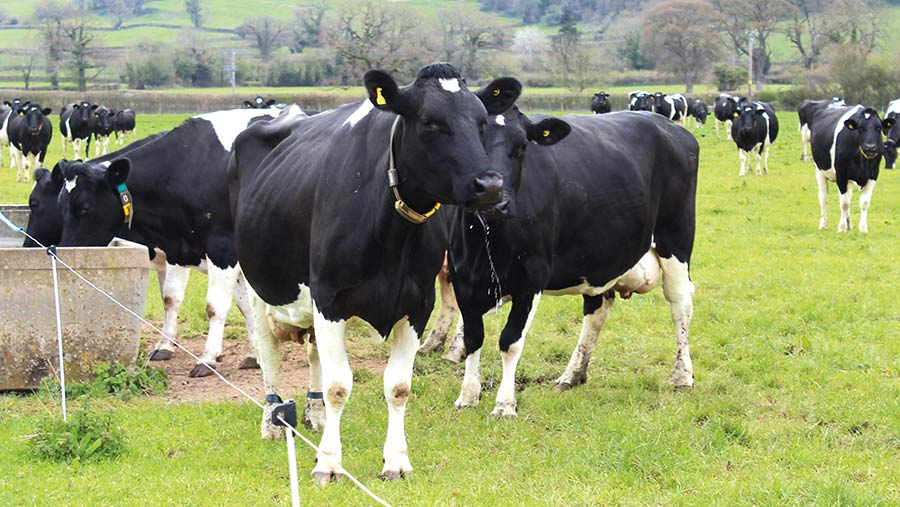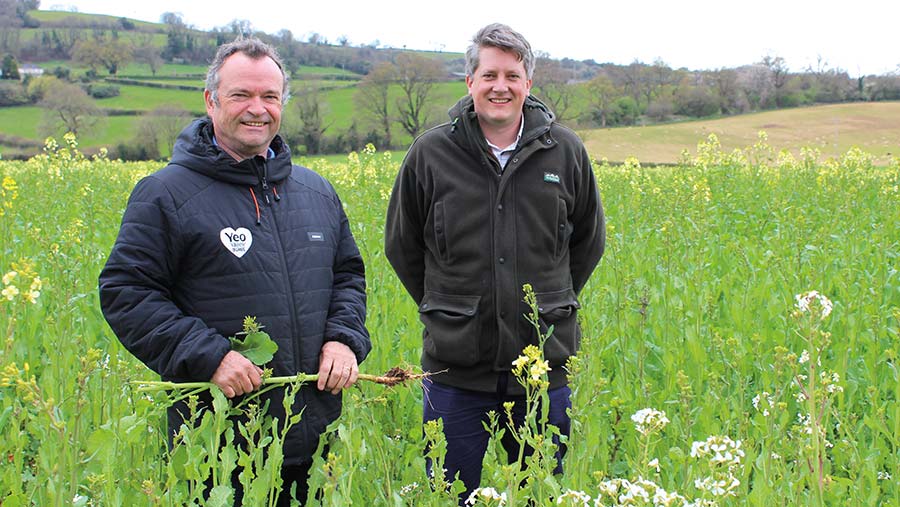How a dairy project aims to increase farm soil carbon by 25%
 © Aly Balsom
© Aly Balsom “Weaponising soils” to boost carbon sequestration is part of Somerset dairy Yeo Valley’s long-term plans to fight climate change, while producing nutritious, healthy food.
The organic dairy brand has set itself the target of increasing soil carbon by 25% in the next 40 years at its two dairies in Blagdon, Somerset.
By doing so, the farms will carry a net carbon footprint of zero, which will help to reduce the overall carbon footprint of the brand (see “Yeo Valley facts”).
Yeo Valley facts
Yeo Valley Farms
- 809ha (2,000 acres) of organic land, including 283ha (700 acres) of managed woodland
- 600 breeding ewes and 200 beef cattle from the dairy
Two dairies
Holt Farm, Blagdon, north Somerset
- 220 pedigree British Friesians, calving in autumn and spring blocks
- 7,800 litres a cow a year at 3.99% fat and 3.23% protein
Yoxter Farm, Mendip Hills, Somerset
- 160 pedigree British Friesians calving September to December
- 7,600 litres a cow a year at 4.10% fat and 3.22% protein
Yeo Valley Organic
- Yeo Valley takes milk from 130 additional UK dairy farmers
- Milk is used to produce a range of organic products including yoghurt, cheese and ice cream
- Half of Yeo Valley’s suppliers are Arla farmers and half are with the Organic Milk Suppliers’ Co-operative (Omsco)
Farming is a key area for attention since it is responsible for 74% of the business’s total carbon footprint.
In 2020, Yeo Valley Farms, with the help of the Farm Carbon Toolkit (FCT), sampled their 809ha (2,000 acres) of farmland to get an indication of soil carbon levels.
Their reasoning was linked to figures from Iowa State University, which showed soils store more carbon than the atmosphere and all of the world’s plants and forests combined.
Tim Mead, director of Yeo Valley Farms, says it is important to recognise this “huge climate asset”, determine base level carbon stocks and ways to raise them.
See also: Reducing emissions is major aim for dairy transition farmers
With one-third more carbon dioxide in the atmosphere than 60 years ago, he believes regenerative agriculture is part of the solution to reversing climate change.
Regenerative farming is focused on agricultural practices that build soil health and increase biodiversity and water cycling with the aim of fighting climate change.
Raising soil organic matter is one way to bolster soil’s carbon storage potential, while also bringing production benefits.
Becky Willson, business development and technical director for FCT, says: “There is a really nice link [between] soil organic matter, soil organic carbon, soil resilience and soil health.” (See “The numbers”).
This means building organic matter and carbon can help with factors such as nutrient cycling, water infiltration and production of quality forage.
The numbers
- 375,439.75t
Total soil carbon stocks measured in carbon dioxide equivalent (CO2e) on Yeo Valley’s two farms in 2020. The aim is to increase this by 25% in the next 40 years - +0.1%
For every hectare of land where the soil organic matter is raised by this much, an additional 8.9t of carbon will be sequestered (FCT) - 58-60%
Percentage of soil organic matter that is soil organic carbon (FCT)
Ways to boost soil carbon
With all these benefits in mind, Yeo Valley has launched the Regenerative Organic Farming Project.
Its 130 dairy farmer suppliers have the option to take part in the project, which will look at farm soil carbon stocks and offer advice on ways to improve.

Tim Mead and Tom White © Aly Balsom
Mr Mead says the project is about learning, collaboration and sharing knowledge beyond the producer group. It is running over five years allow for time to influence soil carbon levels.
So far, 25 farms have had their soils tested.
Yeo Valley Farms is evaluating several ways to boost soil carbon, from which others may learn. Below, organic regenerative farming project manager Tom White runs through some of them:
1. Mob grazing
- Beef cattle from the dairy herds are mob-grazed using a no-fence satellite system across 49ha (120 acres)
- With this system, each animal wears a collar. Once they are in a 5m zone of a virtual fence, a tone is played. If they get too close, a pulse is sent through the collar
- The virtual fence is moved twice daily
- Stock are grazed on hip-height grass at high stocking densities (108 livestock units/ha at peak). Letting the leaf grow longer means more sugar is pushed into the soil. This is a food source for soil microbes, which act as a carbon store when they die. Trampling grass into the ground also benefits soil organic matter.
2. Composting
Aerobic composting
- Farmyard manure (FYM) from loose housing is tipped into rows in fields and turned six times over an eight-week period to accelerate the composting process.
Bokashi – anaerobic composting
- A microbial inoculant is applied to FYM, which is then ensiled
- The aim is to limit losses to the environment and increase nutrient content
- Composting helps to maximise decomposition and soil carbon storage.
3. Diverse cropping
- Last year, peas, oats and barley were wholecropped. They were followed by a cover crop including a variety of species such as tillage radish, red clover, beans, vetch, mustard and forage rape. Half was grazed by sheep and half will be incorporated into the soils as a green manure.
- The different root profiles should help soil organic matter, as should the muck from sheep.
- The trial will assess what the carbon benefits are from each practice.
4. Agroforestry
- 202ha (500 acres) of forestry has been purchased
- Areas where ash dieback is a problem will be replaced with grass and the forest will be grazed with beef and sheep
- A combination of grass and trees is said to have a better carbon capture potential than trees alone.
Soil carbon – four key considerations
The Farm Carbon Toolkit (FCT) is undertaking soil carbon sampling as part of Yeo Valley’s Regenerative Organic Farming Project.
This complements FCT’s existing Soil Carbon Project which has worked with 100 English farms to understand how to measure and improve soil carbon.
Below, Becky Willson, business development and technical director for FCT, gives an overview of key soil carbon considerations.
1. What areas do you look at when measuring soil carbon?
- Soil organic matter
- Soil organic carbon
- Bulk density of the soil – used to calculate tonnes of carbon/hectare and a percentage of carbon in the soil
- Soil health indictors, such as worm counts, infiltration, pH and macronutrients.
2. What impact does soil type and field use have?
Soil type and land use have a strong influence on organic carbon. For example, across Yeo Valley’s own farms, soil organic carbon to 30cm varied from 3.79% to 8.16%.
Clay soils tend to have a greater ability to hold onto carbon than lighter, sandy soils. Generally, arable ground has lower carbon levels than grassland.
3. At what depths are samples taken?
Soil samples are taken at 0-10cm, 10-30cm and 30-50cm depths.
The top layer of the soil is very active, whereas the deeper layers contain longer-term, more stable carbon. Just looking at the top layer can undervalue the amount of soil carbon.
4. How can farmers raise soil carbon?
To raise soil carbon at the top level of the soil, look at feeding more carbon into the system by using organic manures or compost, for example.
To increase deeper soil carbon, think about incorporating deeper-rooting species in sward mixes, resting between grazings and avoiding compaction to allow root elongation.
Case study: Tom and Sophie Gregory, Chard, Dorset
Tom and Sophie Gregory are using their involvement in the Yeo Valley Regenerative Organic Farming Project to develop their soil management strategy and better understand its impact on soil carbon.
The past four years have seen the pair shift attention to regenerative farming principles after discovering a decline in soil nutrient levels across their organic dairy.
Through the Yeo Valley project they will establish baseline soil carbon levels and monitor how management changes impact on them over the next five years.
Farm facts
Home Farm, Chard, Dorset
- Tom and Sophie Gregory in a share-farming arrangement with one other party
- 364ha (900 acres) total
- 360 mainly Irish Friesian cows
- Two-thirds calve in a nine-week spring block, one-third in a nine-week autumn block
- 5,500 litres a cow a year and 440kg milk solids a cow a year
- Arla organic farm supplying Yeo Valley
The first soil carbon samples were taken about two months ago.
Mrs Gregory explains: “Having the data in the future with payments on carbon sequestration is going to be essential [so] getting those baselines done is really important.”
As an Arla organic farm supplying Yeo Valley, all the steps they’re taking are also in line with Arla’s sustainability focus and net zero target.
Mr Gregory believes if farmers want to get to the “holy grail” of net zero, carbon sequestration needs to be a priority.
With that in mind, together with the knowledge that healthy soils are more productive, the couple have made some changes to their system.
1. Increasing species diversity
Multispecies leys have been introduced to encourage greater bacterial diversity within the soils than is present with monocultures, and better grassland productivity.
“If you’ve got a variety of bacteria and fungi, you’ve got the carbon cycle. You’re taking carbon dioxide and storing it in the soil via carbon sequestration,” Mr Gregory explains.
Some of the mixes used include perennial ryegrass, white clover, red clover, festulolium, plantain and sainfoin.
2. Mob-grazing
Youngstock are mob-grazed. In this system, one third of the grass is eaten, one third is trampled in and one third is left.
Mr Gregory says allowing some of the leaf to die and wilt increases the ratio of carbon to nitrogen, so a high carbon food source is added to the soils.
“We’re trying to increase the carbon to nitrogen ratio in the soil. A standard grass ley is 10:1; we’re trying to increase that to 30:1 by mob grazing,” he says.
On good covers, heifers are stocked at 49,420kg of liveweight a hectare on a 12-hour fence move.
3. Direct-drilling
Since 2020, the Gregorys have stopped ploughing and moved to direct-drilling to safeguard soil organic matter and limit the release of carbon dioxide into the atmosphere.
4. Composting
They are also trialling composting of farmyard manure. The aim is to apply it in the growing season to improve nutrient uptake and decrease leaching.
It should also benefit aerobic activity in the soil, soil health and soil cycling, plant growth and carbon sequestration.
